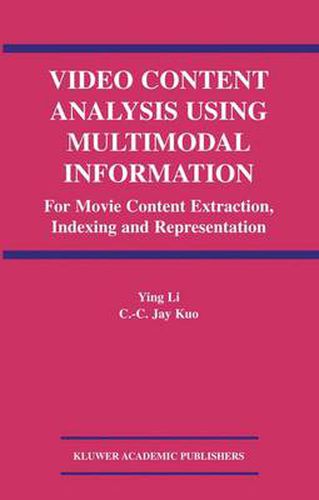Readings Newsletter
Become a Readings Member to make your shopping experience even easier.
Sign in or sign up for free!
You’re not far away from qualifying for FREE standard shipping within Australia
You’ve qualified for FREE standard shipping within Australia
The cart is loading…






This title is printed to order. This book may have been self-published. If so, we cannot guarantee the quality of the content. In the main most books will have gone through the editing process however some may not. We therefore suggest that you be aware of this before ordering this book. If in doubt check either the author or publisher’s details as we are unable to accept any returns unless they are faulty. Please contact us if you have any questions.
This text discusses content-based multimedia analysis, indexing, representation and applications with a focus on feature films. It presents state-of-the-art techniques in video content analysis domain, as well as ideas and algorithms for movie content analysis based on the use of multimodal information. The authors employ multiple media cues such as audio, visual and face information to bridge the gap between low-level audiovisual features and high-level video semantics. Based on sophisticated audio and visual content processing such as video segmentation and audio classification, the original video is re-represented in the form of a set of semantic video scenes or events, where an event is further classified as a two-speaker dialogue, a multiple-speaker dialogue, or a hybrid event. Moreover, desired speakers are simultaneously identified from the video stream based on either a supervised or an adaptive speaker identification scheme. All this information is then integrated together to build the video’s ToC (table of content) as well as the index table. Finally, a video abstraction system, which can generate either a scene-based summary or an event-based skim, is presented by exploiting the knowledge of both video semantics and video production rules. This monograph will be of great interest to research scientists and graduate level students working in the area of content-based multimedia analysis, indexing, representation and applications as well as its related fields.
$9.00 standard shipping within Australia
FREE standard shipping within Australia for orders over $100.00
Express & International shipping calculated at checkout
This title is printed to order. This book may have been self-published. If so, we cannot guarantee the quality of the content. In the main most books will have gone through the editing process however some may not. We therefore suggest that you be aware of this before ordering this book. If in doubt check either the author or publisher’s details as we are unable to accept any returns unless they are faulty. Please contact us if you have any questions.
This text discusses content-based multimedia analysis, indexing, representation and applications with a focus on feature films. It presents state-of-the-art techniques in video content analysis domain, as well as ideas and algorithms for movie content analysis based on the use of multimodal information. The authors employ multiple media cues such as audio, visual and face information to bridge the gap between low-level audiovisual features and high-level video semantics. Based on sophisticated audio and visual content processing such as video segmentation and audio classification, the original video is re-represented in the form of a set of semantic video scenes or events, where an event is further classified as a two-speaker dialogue, a multiple-speaker dialogue, or a hybrid event. Moreover, desired speakers are simultaneously identified from the video stream based on either a supervised or an adaptive speaker identification scheme. All this information is then integrated together to build the video’s ToC (table of content) as well as the index table. Finally, a video abstraction system, which can generate either a scene-based summary or an event-based skim, is presented by exploiting the knowledge of both video semantics and video production rules. This monograph will be of great interest to research scientists and graduate level students working in the area of content-based multimedia analysis, indexing, representation and applications as well as its related fields.